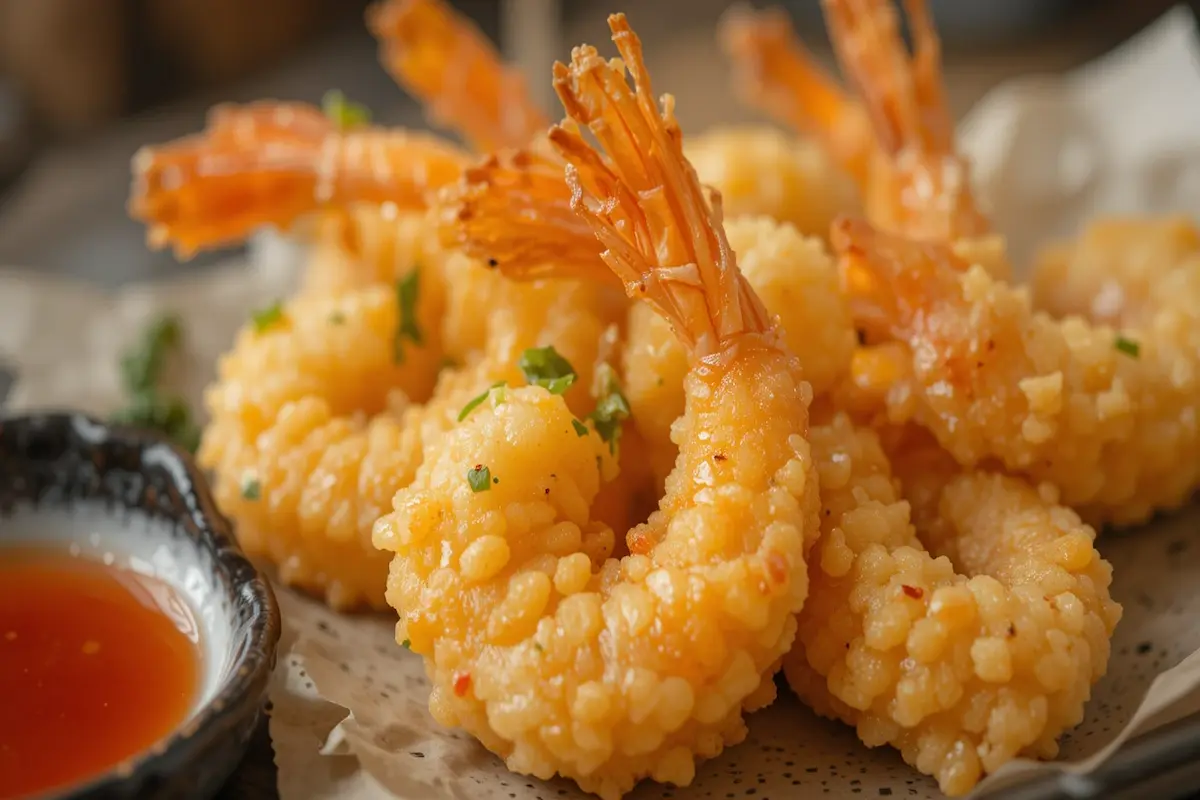Tempura shrimp, a cornerstone of Japanese cuisine, offers a delightful combination of crispy batter and succulent seafood. This guide delves into its history, preparation techniques, variations, and nutritional aspects, providing a thorough understanding of this beloved dish.
Introduction to Tempura Shrimp
Tempura shrimp, known as ebi no tempura (海老の天ぷら) in Japanese, consists of shrimp coated in a light batter and deep-fried to a golden crisp. This dish is celebrated for its delicate flavor and satisfying texture, making it a staple in Japanese cuisine.
The combination of lightly battered shrimp and its crispy exterior makes it a favorite in various culinary traditions, from traditional Japanese meals to fusion dishes. Discover more ideas in Crisp Fresh Recipes.
Historical Origins of Tempura
Tempura shrimp’s origins are deeply rooted in Japan’s history. It’s believed that Portuguese missionaries introduced the technique of batter-frying to Japan in the 16th century. The name “tempura” comes from the Latin word tempora, referring to the periods when Catholics abstained from eating meat, opting for fish and vegetables instead. Over time, this technique evolved into the distinctively light and crispy tempura that we recognize today.
As the dish grew in popularity, tempura shrimp became a well-known part of Japanese cuisine, especially during the Edo period. Understanding the origin of tempura enhances our appreciation for the dish’s rich history.
Selecting the Perfect Shrimp
The key to making the best tempura shrimp lies in selecting the right shrimp. Keep in mind these important factors when choosing shrimp for your tempura:
- Size: Opt for medium to large shrimp, which provide a satisfying bite without being too chewy.
- Freshness: The fresher the shrimp, the better the flavor. It’s recommended to choose shrimp that are firm and have a translucent look.
- Shell: Some prefer to leave the shells on during cooking, as this helps preserve the shrimp’s flavor and prevents overcooking.
Discover more about selecting quality seafood for various dishes in Crisp Fresh Recipes.
Preparing Shrimp for Tempura
Once you have selected your shrimp, proper preparation is essential for a perfect dish. Here’s how to prepare your shrimp for tempura:
- Devein the shrimp: Remove the dark vein that runs along the back of the shrimp to improve flavor and presentation.
- Peel the shrimp: Peel the shrimp, leaving the tail intact for better presentation.
- Straighten the shrimp: Make a few shallow cuts along the underside of the shrimp to prevent it from curling up when frying.
These preparations are essential for maintaining the shrimp’s integrity and ensuring it cooks evenly during frying. Want to dive deeper into shrimp preparation techniques? Check out more at Crisp Fresh Recipes.
Crafting the Ideal Tempura Batter
The perfect tempura batter should be light, crisp, and airy. Here are the key ingredients:
- Flour: Use cake flour or a low-protein flour for a delicate texture.
- Egg: Eggs add richness and help bind the batter together.
- Ice-cold water: This is crucial to achieving a crisp coating; it helps to keep the batter light.
When combining the ingredients, don’t overmix. A lumpy batter will help create the perfect crisp texture when fried.
Mastering the Frying Technique
Achieving perfectly fried tempura shrimp requires attention to detail. Follow these steps for optimal results:
- Oil temperature: Keep the oil temperature between 340°F (170°C) and 360°F (180°C). Too hot, and the batter will burn; too cool, and the shrimp will become greasy.
- Fry in small batches: Frying too many shrimp at once can cause the temperature to drop, resulting in soggy tempura. Fry in small batches for the best results.
- Draining: Once fried, place the shrimp on a wire rack to drain excess oil. This helps the tempura maintain its crispiness.
By following these steps, you can ensure that your tempura shrimp has the perfect texture every time.
Traditional Accompaniments and Dipping Sauces
Tempura shrimp is often served with traditional accompaniments to enhance its flavors. One of the most popular sauces is tentsuyu, which is made from a combination of dashi, soy sauce, and mirin. It’s light, slightly sweet, and perfect for dipping.
- Grated daikon radish: This is often served alongside the tempura to provide a refreshing contrast to the rich, crispy shrimp.
- Rice and vegetables: Tempura shrimp is typically served with steamed rice or alongside vegetables such as tempura-fried sweet potatoes and zucchini.
Modern Variations and Fusion Dishes
While traditional tempura remains a classic favorite, modern chefs and home cooks alike have explored innovative ways to incorporate shrimp tempura into contemporary dishes. For example:
- Tenmusu: This is a delicious fusion of tempura shrimp and onigiri (Japanese rice balls), often wrapped in nori (seaweed).
- Tempura tacos: A trendy fusion dish that combines Ebi shrimp with taco ingredients, offering a fun and exciting twist on two beloved dishes.
Tempura shrimp’s versatility allows for endless possibilities, and it’s no surprise that it has been embraced in various global culinary traditions. If you’re interested in more fusion ideas, discover more in Crisp Fresh Recipes.
Nutritional Information and Health Considerations
Tempura shrimp offers a rich combination of protein and fat, making it a satisfying dish. For example, a serving of five pieces of shrimp tempura contains approximately:
- Calories: 260
- Fat: 17g
- Protein: 11g
While delicious, Ebi shrimp can be quite high in calories and fat. If you’re looking for a healthier version, consider the following alternatives:
- Batter modifications: Use whole wheat flour or an alternative flour to increase fiber content and reduce processed ingredients.
- Baking or air frying: Instead of deep frying, you can bake or air fry your tempura shrimp to reduce the oil content.
Want to know more about making healthier versions of classic dishes? Visit Crisp Fresh Recipes.
Frequently Asked Questions
What is the origin of Ebi shrimp?
Ebi shrimp originated in Japan, influenced by Portuguese missionaries in the 16th century who introduced batter-frying techniques. (en.wikipedia.org)
How can I prevent shrimp from curling during frying?
To prevent curling, make shallow cuts along the underside of the shrimp’s abdomen before frying.
Can I make shrimp tempura ahead of time?
Ebi tempura is best enjoyed immediately after frying to maintain its crispness. However, you can prepare the batter and shrimp in advance and fry them just before serving.
What are some common mistakes to avoid when making shrimp tempura?
- Overmixing the batter: This can lead to a dense coating.
- Incorrect oil temperature: Too hot or too cold oil can affect the texture.
- Overcrowding the pan: Frying too many shrimp at once can cause them to stick together and cook unevenly.
How can I make a gluten-free version?
Use rice flour or a gluten-free flour blend in place of wheat flour to create a gluten-free batter.
By understanding the history, preparation methods, and variations of tempura shrimp, you can appreciate its place in Japanese cuisine and enjoy crafting this dish at home. Whether you enjoy it in its classic form or as part of a modern fusion dish, Ebi shrimp offers endless possibilities to experiment and savor.
Conclusion
Ebi shrimp is a beloved dish that showcases the perfect combination of delicate seafood and crispy batter. From its historical roots in Japan, influenced by Portuguese missionaries, to its modern interpretations in various fusion dishes, tempura shrimp has remained a favorite in kitchens around the world.
The key to making excellent tempura shrimp lies in selecting the right shrimp, preparing them properly, and mastering the batter and frying techniques. By understanding the principles behind each step, you can ensure that your tempura shrimp turns out light, crisp, and delicious every time.
Whether you’re serving it as a traditional appetizer with dipping sauces and rice or as part of a contemporary fusion dish like tenmusu or tempura tacos, there are countless ways to enjoy this dish. With simple modifications, such as using healthier batter ingredients or alternative cooking methods, you can even adapt tempura shrimp to suit various dietary needs.
So, the next time you’re craving a deliciously crispy seafood treat, take a moment to appreciate the history and versatility of tempura shrimp. Armed with these tips and techniques, you’re ready to create your very own perfect Ebi shrimp—whether you’re enjoying it in its traditional form or experimenting with new variations. Don’t forget to explore more ideas for pairing and adapting tempura shrimp in your next culinary adventure by checking out Crisp Fresh Recipes.

